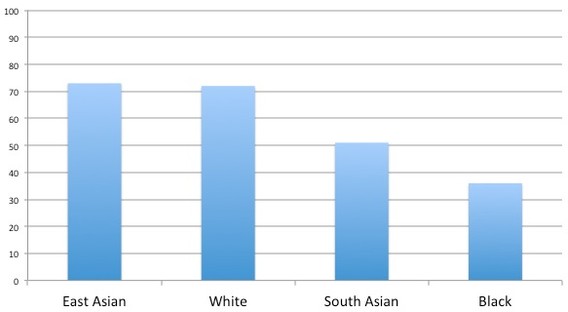
Thirty-seven percent of white Americans believe that the police treat black people less fairly; 70 percent of black Americans feel the same way. Similar chasms exist when it comes to perceived discrimination in stores, the courts, and schools, which means that much of the nation’s dialogue about racial inequality is defined by the clashing of intractable subjectivities.
Data alone can’t solve deep-seated social ills or mediate heated arguments, but it does have a habit of pulling conversations away from foggy abstraction and ad hominem accusations. That’s why studies showing that employers prefer to hire candidates with caucasian-sounding names over those with black-sounding ones and that the racial composition of juries affects trial outcomes are so powerful. And it’s why “Still Not Allowed on the Bus,” a working paper published late last year by two researchers based in Australia, is a meaningful contribution to a body of evidence indicating that racial discrimination is real, concrete, and pervasive.
Those two researchers are Redzo Mujcic and Paul Frijters, and their paper describes the results of an experiment they arranged in the state of Queensland, Australia. Mujcic and Frijters liken the racial overtones of Queensland’s history to those of the American South; it took until 1963 for black Aboriginals to gain the right to vote in Australia. In their experiment, Mujcic and Frijters enlisted 29 volunteers from different racial and ethnic backgrounds to board public buses, tell the drivers that they lacked the roughly $3.50 needed to ride, and say that they needed to get to a stop about a mile away. They were then asked to record whether the driver let them stay onboard. (They were also told to note the time of day and the weather conditions, which the researchers figured could engender compassion among the bus drivers.)
In all, the experiment yielded data on more than 1,500 encounters between volunteers and drivers. Nearly two-thirds of the volunteers’ pleas were successful, but the rate at which they were granted differed greatly across ethnicities. White participants were given a lot more leeway than black ones: 72 percent of white subjects were allowed to stay onboard, while only 36 percent of black ones were. The rate for South Asian subjects was around 50 percent, and for East Asians it was 73 percent.
Percentage of Passengers Who Were Allowed to Ride for Free, by Ethnicity
 Data: Mujcic and Frijters
Data: Mujcic and Frijters
The researchers also put two twists on their experiment. First, they had subjects dress in businesswear in order to look wealthier, and see if that might change the chances that a rider wouldn’t be kicked off. They then had some subjects put on military getup to make them appear more patriotic. When black people wore a suit or an army uniform, they saw their chances of staying onboard increase roughly twofold. This put them in the same statistical neighborhood as white participants who were dressed casually—though when white people were instructed to wear this clothing, the percentage of them who stayed onboard jumped into the mid-90s.
Percentage of Passengers Who Were Allowed to Ride for Free, by Ethnicity and Attire
 Data: Mujcic and Frijters
Data: Mujcic and Frijters
Erika Hall, a professor of organization and management at Emory University, has also conducted research that puts numbers on racial discrimination. “When we quantify implicit biases, people are given a tangible representation of the cost of prejudice,” she says. “Many people conceptualize prejudice as being subjective, emotional, and open to the interpretation of the victim. However, thinking of prejudice in this way can lead to ‘victim blaming’ because people assume that the victim’s depiction of the events is self-serving. By quantifying these biases, researchers make the bias more objective.”
Thinking of discrimination numerically is not without its pitfalls, though Hall believes they’re more than nullified by the usefulness of empirical data. “The potential downside is that when people have a quantitative statistic…they [can] fail to realize that these studies took place in a specific context and with a specific population,” she says. “Thus, the research context may not be generalizable to the one that they are referencing.” This is not an argument for completely dismissing the findings of the Queensland study, but rather for replicating it in other countries.
Once biases have been catalogued objectively, there remains the problem of what to do about them. A side experiment that Mujcic and Frijters describe in their paper hints at one possible solution. They approached several bus drivers on break, showing them a picture of a subject from the original experiment and asking the driver if that rider would be allowed to stay on. In that survey, 86 percent of drivers said they’d let a black passenger stay onboard—a rate far higher than what happened out on the streets. Perhaps drivers know that they shouldn’t discriminate, but only act on that knowledge when they think their actions are being recorded. Putting policies in place that force people to step outside of their everyday rhythms and evaluate their own fairness might be a useful strategy. Or maybe it comes down to devising something that makes them feel the pressure of that ultimate motivator, social pressure.














